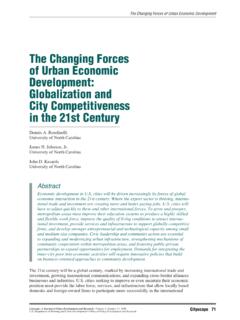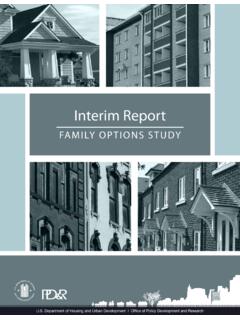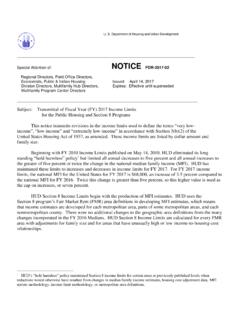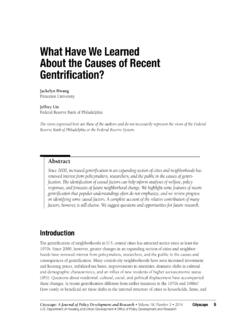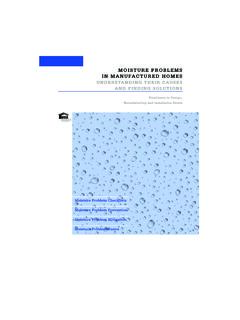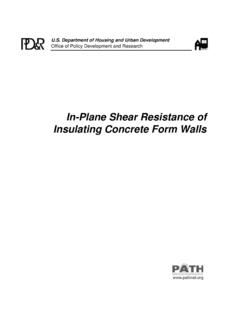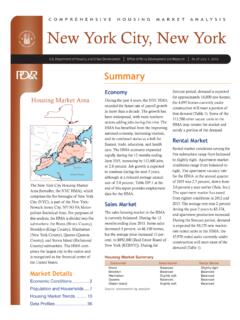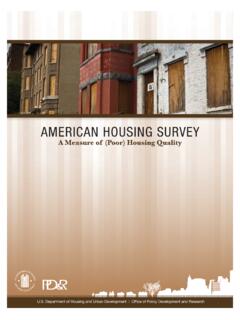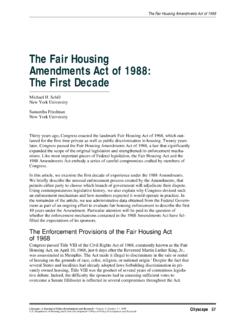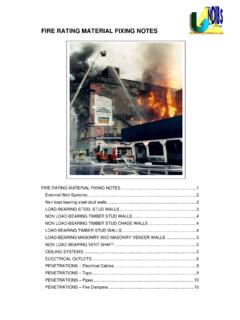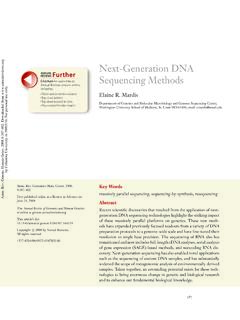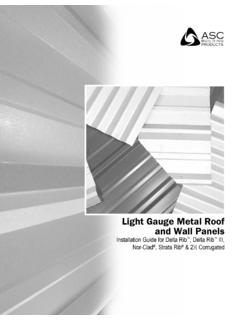Transcription of PART A: Usable Kitchens PART B: Usable Bathrooms
1 Chapter Seven: REQUIREMENT 7 Usable Kitchens and Bathrooms part A: Usable Kitchens part B: Usable Bathrooms 7 part A: Usable Kitchens 7a ..covered multifamily dwellings with a building entrance on an accessible route shall be designed and constructed in such a manner that all premises within covered multifamily dwelling units contain Usable that an individual in a wheelchair can maneuver about the space. Fair Housing Act Regulations, 24 CFR part TWO: CHAPTER 7 counters may be at the standard height of 36" (counter height of 34" as shown in Fig. 2(c) of the Guidelines does not apply) lever hardware, although preferred and more Usable by everyone, is not required ranges and cooktops may have front-, rear-, or side-mounted controls; for safety reasons and ease of use, front- or side-mounted controls are preferred Notes in italic type are recommendations only and are not required by ANSI or Guidelines.
2 FAIR HOUSING ACT DESIGN MANUAL Kitchens in covered units must be on an accessible route and have door open ings at least 32" clear to allow passage; see Chapter 4 Usable Doors and Chapter 5 Accessible Route outlet located beyond reach of seated person permitted if other outlets in accessible locations are provided, see Chapter 6 Switches, Outlets, and Controls adequate space within the kitchen to provide 30" X 48" clear floor space at each fixture and appliance in U-shaped Kitchens , if less than 60" between the two legs of the U, then sink base must be removable, see page Guideline Specifications for Kitchens Usable Kitchens AND Bathrooms part A: Usable Kitchens INTRODUCTION Kitchens that comply with the Fair Housing Accessibility Guidelines (the Guidelines) can be designed to look and function like conventional Kitchens typically found in multifamily housing.
3 The Guidelines specify that three specific require ments must be provided to allow people who rely on mobility aids to use the kitchen . Usable Kitchens , as specified in the Guidelines, are not necessarily accessible Kitchens , but they do provide maneuvering space for a person who uses a wheelchair, scooter, or walker to approach and operate most appliances and fixtures. The Guidelines 1) specify minimum clear floor spaces at fixtures and appliances, 2) define minimum clearance between counters, and 3) provide additional specifications when a U-shaped kitchen is planned. Wheelchair turning spaces, described in accessibility standards, are not required in Kitchens that meet the Guidelines, except in some U-shaped Kitchens , see page Additional supplemental design infor mation, presented in italic type, is offered for designers/builders who may wish to increase the accessibility of dwelling units.
4 This supplemental information is not required by HUD, the Fair Housing Act, or the Guidelines. CLEAR FLOOR SPACE AT FIXTURES AND APPLIANCES The Guidelines specify that a 30-inch x 48-inch clear floor space be provided at each kitchen appliance or fixture, and that each of these clear floor spaces adjoin the accessible route that must pass into and through the kitchen . It is anticipated that in any conventional kitchen plan, the over lapping of the minimum 36-inch wide accessible route with the clear floor spaces at all fixtures and appliances provides the necessary maneuvering space to make it possible for a person using a mobility aid to approach, and then position himself or herself close enough to use the fixture safely. The clear floor space must be positioned either parallel or perpendicular to and centered on the appliance or fixture, , the clear floor space must have its centerline aligned with the centerline of the fixture or appliance.
5 This centered position is most critical at corners where an appliance may have to be pulled away from the corner to allow a full centered approach. The two types of ap proaches and where they are necessary are described on the following pages. 30" X 48" clear floor space Clear Floor Space for Wheelchair Parking at Appliances and Fixtures 30" part TWO: CHAPTER 7 FAIR HOUSING ACT DESIGN MANUAL Overlapping Clear Floor Spaces and AccessibleRoute Provide Maneuvering Space one 30" X 48" clear floor CLEAR FLOOR SPACE AT clear floor space spaces adjoining RANGES, COOKTOPS, AND SINKS at each fixture accessible route and appliance (not into kitchen Unless knee space is provided, space to execute a required at sink if parallel approach must be provided at ranges, base cabinets are removable) cooktops, and sinks. The clear floor space in this parallel orientation allows the wheelchair user to make a close side approach permitting safer and easier reach to controls and cooking surfaces.
6 A forward approach, on the other hand, is difficult and unsafe, especially when controls are located at the back, because it requires seated users to lean forward over their feet and knees to reach not only hot pots and pans but the controls as well. See pages through for required clear floor space at cooktop or sink when knee space is provided. 48" 30" clear floor space for a parallel approach must be centered on fixture centerline of clear floor space centerline of range user pulls parallel to range Space for parallel Approach Required at Range and Cooktop Usable Kitchens AND Bathrooms part A: Usable Kitchens Forward Approach at Range parallel Approach to Range is Difficult and Unsafe Specified in Guidelines centerline of sink clear floor space centered on bowl A parallel approach also must be provided at sinks so a seated user can reach down into the bowl.
7 A forward approach with kneespace below the sink may be required in some very small U-clear floor spaceshaped Kitchens . See page centered on overall The parallel clear floor space at sinks, as at sink when bowls are ranges and cooktops, must be centered on the bowl of unequal size or appliance. At single bowl sinks the centerline of the clear floor space must align with the centerline of that bowl. Where there are multiple bowl sinks the clear floor space must be centered on the clear floor space centered on double overall sink itself. basin sink Faucets usually are placed at the center of or within six inches of the center of the sink, regardless of the number of basins. Since the clear floor space is centered on the sink, users are still afforded access to faucet controls. Space for parallel Approach Required at Sinks part TWO: CHAPTER 7 FAIR HOUSING ACT DESIGN MANUAL CLEAR FLOOR SPACE AT OVENS, DISHWASHERS, REGRIGERATORS, FREEZERS, AND TRASH COMPACTORS The 30-inch x 48-inch clear floor space oriented in either one of two positions parallel or perpen-dicular is required at the oven, dishwasher, refrigerator, freezer, and trash compactor.
8 Wall-clear floor space for at least one type of approach (forward or parallel ) must be centered on the refrigerator; this applies to side-by-side as well as over/under models mounted and microwave ovens, like ovens in ranges, also must have either a parallel or perpen dicular clear floor space adjacent to the appliance. Even though this group of appliances has operable doors that require the user to be able to get out of the way of the door swing, for purposes of design and room layout the clear floor space must be centered on the appliance itself. However, the clear floor space for the specific appliance and the clear floor space for adjacent appliances and fixtures, combined with the 36-inch wide accessible route into the room, provide the functional space necessary to open a door and maneuver close to the appliance to be able to reach into it. REF30" perpendicular or 48" Space for Either a Forward or parallel Approach Must be Provided forward approach parallel approach range Functional Use of Oven forward approach to oven racks parallel approach to oven racks Could Be From Any One of These Positions Usable Kitchens AND Bathrooms part A: Usable Kitchens CLEARANCE BETWEEN COUNTERS AND ALL OPPOSING ELEMENTS The Guidelines require a clearance of at least 40 inches between all opposing base cabinets, countertops, appliances, and walls.
9 The 40-inch clearance is measured from any countertop or the face of any appliance (excluding handles and controls) that projects into the kitchen to the opposing cabinet, countertop, appliance, or wall. Refrigerators vary greatly in depth and may extend up to eight inches beyond cabinet faces. Standard free-standing and drop-in ranges may project up to three inches. Appliance depths (excluding door handles) must be included when calculating the 40-inch clearances. base cabinet range (excluding cabinet handles) 40" min. Minimum Clearance between Range dimension must be measured from front face of range or refrigerator to countertop edge and appliance and Opposing Base Cabinet base cabinet 40" min. refrigerator Minimum Clearance between Refrigerator and Opposing Base Cabinet part TWO: CHAPTER 7 FAIR HOUSING ACT DESIGN MANUAL In a narrow kitchen the 40-inch minimum clear-wheelchair user must 30" X 48"ance provides an additional five inches on either leave kitchen to turn around clear floor side of the required clear floor space of 30 inches x space 48 inches at each fixture or appliance, so a user in a wheelchair can maneuver as close as possible to appliances or fixtures.
10 A narrow kitchen such as the one shown to the right meets the Guidelines and is Usable , but may be difficult for many people using wheelchairs. Its narrow corridor design requires a user in a wheelchair to exit the kitchen to turn around. REF DW 5" 30" 40" min. 5" 40" Minimum Clearance Between all Counters, Base Cabinets, Appliances, and Walls In more elaborate Kitchens where an island is planned, the 40-inch clearance must be maintained between the face of the island and all opposing features. Even though an accessible route for a 90 degree turn around an obstruction is 36 inches, to ensure sufficient space for maneuvering within the kitchen , the Guidelines require that the minimum clearance of 40 inches be maintained. 40" min. 40"min. 40" Must Be Maintained Between Island and all Opposing Features Usable Kitchens AND Bathrooms part A: Usable Kitchens machine is planned to be included adjacent to the REFor the clear floor space at the sink 30" X 48" clear floor space on sink sink base DW 64" min.
